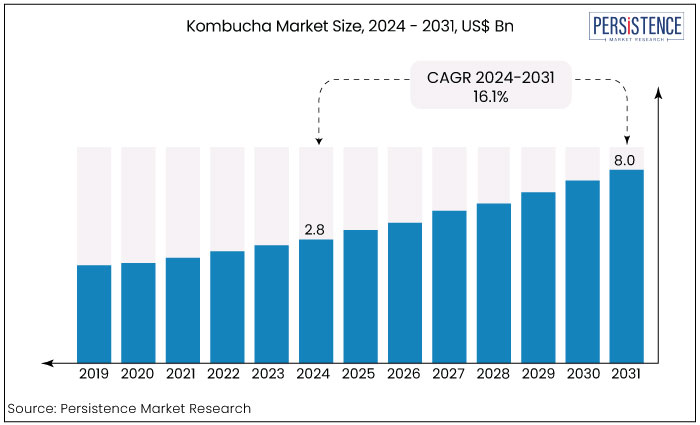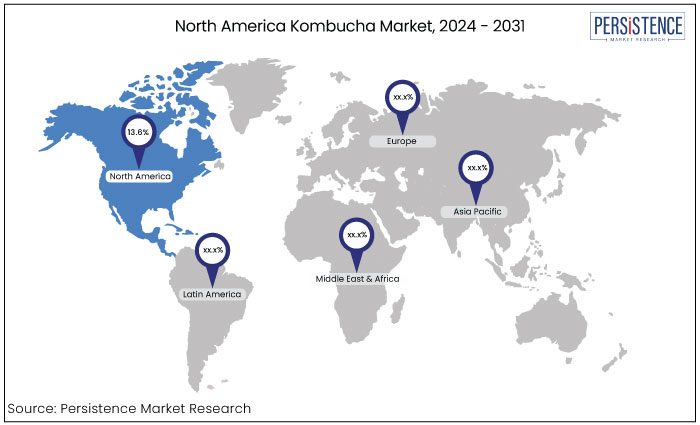ID: PMRREP34616| Upcoming | Format: PDF, Excel, PPT* | Food and Beverages

The global kombucha market report estimated the market value at US$8.0 Bn by the end of 2031, up from US$2.8 Bn recorded in 2024. The market is expected to secure a CAGR of 16.1% in the forthcoming years from 2024 to 2031.

Key Highlights of the Market
|
Market Attributes |
Key Insights |
|
Kombucha Market Size (2024E) |
US$2.8 Bn |
|
Projected Market Value (2031F) |
US$8.0 Bn |
|
Forecast Growth Rate (CAGR 2024 to 2031) |
16.1% |
|
Historical Growth Rate (CAGR 2019 to 2023) |
13.6% |
Kombucha, a fermented tea beverage, has emerged as a significant drink in the global health and wellness industry. This tea of immortality has changed throughout time from a traditional elixir to a popular health drink that is enjoyed by millions of people around. It is a frothy, acidic beverage high in probiotics, antioxidants, and organic acids that is prepared by fermenting sweetened tea with a symbiotic culture of bacteria, and yeast (SCOBY).
When it comes to what is kombucha, its distinct flavor, a host of kombucha benefits have drawn the primary interest of health enthusiasts, resulting in a growing market that offers an array of tastes, formulas, and creative packaging.
It has become a mainstay in the diets of many people looking to enhance their digestion, detoxify, and general well-being, thanks to the growing consumer shift towards natural, organic, and functional beverages.
Companies are experimenting with a broad variety of natural flavors, including fruits, herbs, spices, and botanicals to satisfy a wide range of customer palates and provide distinctive flavor profiles.
Innovative tastes that appeal to both conventional and daring consumers have resulted from this, such as berry-basil, lavender-mint, and ginger-turmeric. Innovative kombucha packaging designs will be another factor accelerating market growth.
Although glass bottles continue to be preferred for their high-end feel and capacity to maintain the beverage's quality, there is a growing movement towards packaging solutions that are more portable, and handy.
The historical period witnessed a notable surge in consumer knowledge and preference for health and wellness products, which in turn drove demand for functional beverages. Due to its probiotic composition, kombucha is a popular choice for people looking to support gut health and strengthen their immune system, in line with the worldwide health trend highlighted by the COVID-19 pandemic.
Furthermore, the market analysis shows it gained from the spread of novel tastes and product variations that appealed to a wider range of consumers with varying taste preferences. The expanding geographical reach is set to drive market growth. Future expansion is also being facilitated by increased investment in kombucha research and development.
Businesses are looking for ways to fortify kombucha such as by adding vitamins, minerals, or other useful ingredients to increase its health advantages. This not only addresses especially health concerns of diverse consumer groups but also helps products stand out in a competitive market.
Increasing Innovation in Flavors and Product Formulations
Companies are always releasing new and distinctive flavors to appeal to a wider range of consumers as customer preferences change and become more diverse. Beyond the flavors of classic fruits, this innovation includes unusual herbs, spices, botanicals, and even combinations inspired by food.
Additionally, product formulas are being improved to meet certain customer needs. For example, low-sugar or caffeine-free products appeal to people who are health-conscious.
Further broadening its appeal to a wider range of nutritional requirements, including as vegan, gluten-free, and organic, is the capacity to customize.
In addition to helping firms stand out in a congested market, these innovations encourage brand loyalty as customers look for distinctive and high-quality products.
Consumer Shift Towards Healthier Lifestyle Choices and Alternative Beverages
Consumers are actively looking for beverages that offer functional benefits without sacrificing taste, as they prioritize health and fitness. These tastes are wonderfully complemented by kombucha, which has a high probiotic content, antioxidants, and organic acids from fermentation.
The change reflects broader consumer tendencies toward natural and clean-label products, where they are aware of the contents and additives and how they affect their health overall.
Furthermore, kombucha's allure as a cooling substitute for artificial drinks, and sugar-filled sodas has drawn a wide range of consumers, including those who are trying to cut back on their sugar intake and health aficionados.
The beverage's attractiveness is further enhanced in a market that is becoming more and more focused on preventative health measures due to its associations with immune boosting, detoxification, and digestive health.
Concerns with Regulations Pertaining to the Amount of Alcohol in Fermented Drinks
Natural fermentation results in the fermentation process producing minute amounts of alcohol as a byproduct. Regulations pertaining to the manufacturing, labelling, and distribution of alcoholic beverages are enforced in numerous nations.
Included in this are the regulations governing the maximum amount of alcohol allowed, which might differ significantly between states. It can be difficult for producers to comply with these rules.
Monitoring and testing alcohol levels closely during the fermenting and bottling processes is often necessary to ensure compliance. Falling short of these regulations can have negative effects on a brand's reputation and market presence, including fines, product recalls, or even legal action.
Development of Innovative Variants Targeting Specific Health Benefits
Herbs having anti-inflammatory qualities like ginger and turmeric, or adaptogens with stress-relieving qualities like ashwagandha and holy basil, can be added to kombucha recipes. These additions not only improve the beverage's nutritional profile but also satisfy customers who are searching for focused remedies for typical health issues.
In addition, the launch of variations enhanced with vitamins, minerals, or antioxidants can help set items apart in a crowded market. Brands can position themselves as leaders in the functional beverage market and draw in health-conscious consumers by emphasizing the health advantages of their ingredients.
The tactical approach not only stimulates innovation in products but also increases market penetration and cultivates customer loyalty by reaching a wider range of consumers who place a high value on their health and wellbeing when making decisions.
Eco-Friendly Packaging Solutions
Growing consumer consciousness regarding environmental concerns like plastic pollution, and carbon footprints has led to a more discriminating approach towards product packaging.
Businesses who prefer eco-friendly packaging might attract more customers from this expanding market. This can entail using glass bottles that can be recycled, biodegradable or compostable materials, or packaging composed of recycled post-consumer products.
Using environmentally friendly packaging solutions improves a brand's reputation and placement in the market while also being in line with the values of consumers who care about the environment.
Companies that place a high priority on sustainability can highlight this dedication in their marketing campaigns by highlighting how they help lessen their environmental effect and advance the circular economy.
Such kinds of programs can draw in a devoted following of customers, especially from millennials, and Gen Z consumers, who are more inclined to support companies that practice environmental responsibility.
|
Category |
Projected CAGR through 2031 |
|
Packaging Type - Bottle |
14.5% |
|
Nature - Organic |
18.5% |
Bottle to be the Top Packaging Format
The look and feel of glass bottles appeal to consumers who are health-conscious and environmentally sensitive, which is frequently the driving force behind kombucha sales. Glass's visual transparency reassures customers of the beverage's quality and purity and allows them to view the product, which can boost satisfaction and trust.
Furthermore, glass is completely recyclable and frequently chosen by firms that are dedicated to sustainability and eco-conscious consumers, following the general market trend towards a decrease in the waste produced by plastic.
Glass bottles offer a flexible surface for eye-catching labeling and branding in terms of marketing and branding, which can improve shelf appeal and consumer identification. Because consumers may reuse glass bottles, increasing their perceived value and lowering their overall environmental effect, their durability and reusability also contribute to their popularity.
Organic Variant to Grow Notably in Long Term
Consumers who value natural, chemical-free products that are seen to be safer and healthier are drawn to organic kombucha, which is created from ingredients that have received certification as organic.
The millennial, and Gen Z who are spearheading the organic movement, have a particularly high affinity for organic foods. Furthermore, consumers' desire for products with clear, uncomplicated ingredient lists devoid of artificial additives, and preservatives has increased due to the clean-label movement.
Clean-label enthusiasts find comfort in the assurance that organic certification offers regarding the product's purity and adherence to strict farming and processing standards. This assurance is a key differentiator in the increasingly crowded kombucha market, where consumers are faced with numerous options.
|
Region |
CAGR through 2031 |
|
North America |
13.6% |
|
Europe |
15.2% |
Kombucha to Grow as a Popular Choice in North America
North America region is the largest revenue contributor in the global market and is expected to grow at a CAGR of 13.6% during the forecast period. In North America, where consumers are increasingly looking for natural, functional beverages that provide health advantages beyond simple hydration, the trend toward health and wellness is particularly strong.
Because it perfectly fits these criteria and is high in probiotics, antioxidants, and organic acids, kombucha is a popular choice among health-conscious customers who place a high priority on gut health, immunity, and detoxification.
Furthermore, the market for natural and organic products is well-established in North America, where a sizeable segment of the populace is willing to pay a premium for goods that are thought to be healthier and more sustainable.
The readiness of the North American consumer to spend money on natural, high-quality goods has increased demand, particularly for organic varieties, which has further accelerated market expansion.

Kombucha Consumption on the Rise in Europe
The European market is projected to secure a CAGR of 15.2% in the forecast period from 2024 to 2031. This region is seeing a sharp increase in demand for natural and organic products, with a particular emphasis on clean-label goods devoid of artificial additives and preservatives.
The health-conscious market responds favorably to organic variety, which meets strict organic certification requirements. In addition, the availability in Europe has greatly increased due to the development of distribution networks.
Prominent supermarkets, health food stores, and internet retailers have expanded their selection of kombucha drinks, facilitating the purchase process for customers. Another significant factor is the growth of e-commerce and direct-to-consumer sales models, especially after the COVID-19 pandemic pushed the market trends of online shopping.
Innovation remains a key competitive strategy, with companies continuously exploring new flavors, functional ingredients, and packaging formats to differentiate their products and attract diverse consumer segments.
Influencer collaborations, social media platforms, and direct-to-consumer internet sales are all being used by brands to increase customer engagement and enhance brand loyalty. With their ease and ability to build long-lasting relationships with customers, subscription services that deliver kombucha monthly are also becoming more and more popular.
Consumer shift towards healthier lifestyle choices, and alternative beverages is surging the demand.
Bottle are expected to hold the significant kombucha market share.
Developing variants targeting specific kombucha advantages can present significant opportunities in the market.
North America to account for the significant share in the kombucha market.
Some of the leading kombucha companies include Kombucha Wonder Drink, Makana Beverages LLC, Kosmic Kombucha, Live Soda LLC, Reed’s Inc., and Hudson River Foods.
|
Attributes |
Details |
|
Forecast Period |
2024 to 2031 |
|
Historical Data Available for |
2018 to 2023 |
|
Market Analysis |
US$ Billion for Value |
|
Key Regions Covered |
|
|
Key Market Segments Covered |
|
|
Key Companies Profiled in the Report |
|
|
Report Coverage |
|
|
Customization & Pricing |
Available upon request |
By Type
By Nature
By Packaging Type
By Sales Channel
By Region
Delivery Timelines
For more information on this report and its delivery timelines please get in touch with our sales team.
About Author